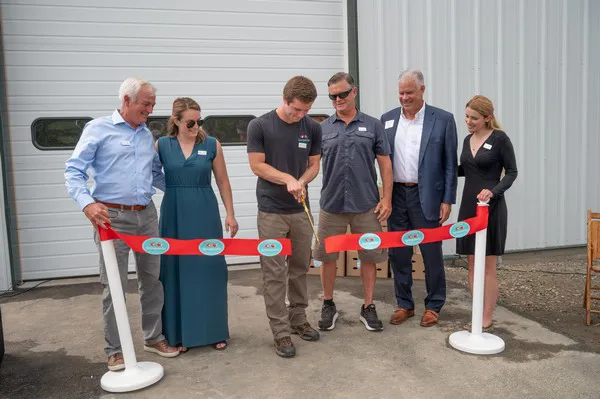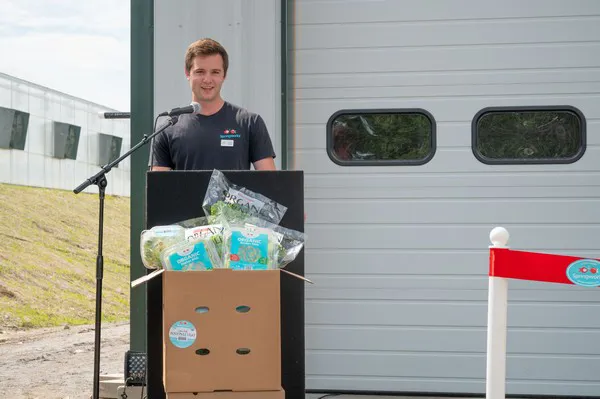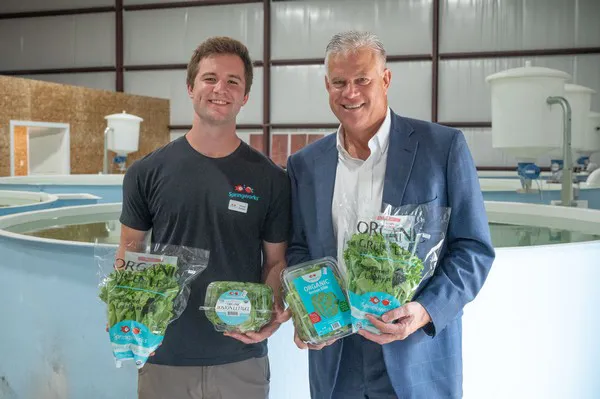Here are some remarkable numbers for you. Trevor Kenkel is 26 years old today. He started growing lettuce and fish in an aquaponic setting 10 years ago and founded his company Springworks Farm in 2014. Springworks Farm grew to 27,000 square feet and last Saturday, its first new 40,000-square-foot aquaponic greenhouse was opened, the next step in their growth plan to 500,000 square feet. "In the U.S., 95% of lettuce is grown in the deserts of California and Arizona, and the COVID outbreak exposed the risks inherent to our centralized industry," Trevor explains.

Fish and lettuce
Bibb, Romaine, leaf lettuce, salad mix, and other produce, as well as thousands of additional pounds of tilapia. It will all be coming from the new Springworks Farm greenhouse. In fact, with the grand opening of greenhouse number three, Hannaford Supermarkets just recently named Springworks their sole provider of organic green leaf lettuce, with more likely to come. Trevor started the company as he believes in a farming future that prioritizes people and the land they depend on while providing their community with fresh, healthy greens. Still, combining fish and food isn't easy. "Balancing the nutrient concentrations and biological requirements of our fish and lettuce requires approaching aquaponics as a living ecosystem. Fish and lettuce have different but largely complementary needs, and we have fine-tuned the natural processes to optimize growth, health, and nutrient availability."
With a dynamic system, Springworks has a monitoring structure in place that allows them to make adjustments as needed. "By taking advantage of naturally occurring biological relationships, we can maximize efficiency and minimize inputs, making our system the most sustainable controlled environment approach."
Their sustainable, innovative, and local growing concept has gotten the market excited about the Springworks Farms products – as well as the fact that their produce is organic and available at a competitive price point. "Over the last five years, we have seen a greater emphasis on organic and high-quality local produce at every level of the supply chain," Trevor says. "Consumers care about how and where their food is produced, and how the people at the heart of it all are treated. They have made it clear that they prefer to support farms that align with their values and health."

Trevor is quite sure this has been the foundation of the company's growth. "The relationships we have formed with our customers reflect how we center quality and sustainability while creating meaningful jobs in the community."
Growing locally also responds to the challenges growers face day-to-day: the increasing cost of transportation and labor scarcity, for example. "Larger challenges are far more structural, such as inequitable access to land and loans that create a barrier to entry for people who want to enter the field."
It all results in the greens industry moving away steadily from centralized production to a regional model that is more responsive to the supply chain. "Our expansion is a direct response to meet the growing demand for safe, local, organic lettuce", says Trevor. And all of that gained further momentum when COVID happened. "COVID sped up our plans because demand from retailers became urgent," Trevor says. "It exposed the risks inherent to our centralized industry. As a regional producer, our ability to help build a resilient and sustainable food system has never been more crucial."

Trevor Kenkel with Hannaford President Mike Vail
While opening up the first expansion, Trevor also looks further ahead. "Localized farms, growing, and distribution can be tailored to meet regional demand and less vulnerable to disruption of any kind. Greater proximity between farmers and consumers means fresh, safe lettuce that requires less intensive inputs than a centralized model, and this will probably continue."
That's why the company plans to expand from 27,000 square feet to 500,000 square feet over the next six years. "Yet we want to be very intentional about scaling our operations appropriately over time. Our biggest concern is maintaining quality product and service as we expand, in addition to ensuring we are on-trend with what consumers and our clients want and need." To keep an eye out for that, Trevor wants to continue to combine business strategy with facility design. "My goal is to balance industry dynamics and technology so that short- and long-term goals are reflected in our growth. I am lucky to have a team, including my sister Sierra, to support the farm and our growing retail operations and brand development, to help me focus on making sure we can continue to achieve our goal of fresh, organic products for everyone who wants them."
